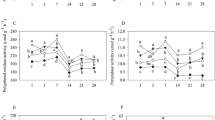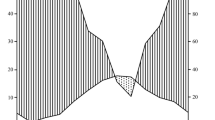Abstract
Tannins are abundant secondary chemicals in leaf litter that are hypothesized to slow the rate of soil-N cycling by binding protein into recalcitrant polyphenol–protein complexes (PPCs). We studied the effects of tannins purified from sugar maple, red oak, and eastern hemlock leaf litter on microbial activity and N cycling in soils from northern hardwood–conifer forests of the northeastern US. To create ecologically relevant conditions, we applied tannins to soil at a concentration (up to 2 mg g−1 soil) typical of mineral soil horizons. Sugar maple tannins increased microbial respiration significantly more than red oak or hemlock tannins. The addition of sugar maple tannins also decreased gross N mineralization by 130% and, depending upon the rate of application, decreased net rates of N mineralization by 50–290%. At low concentrations, the decrease in mineralization appeared to be driven by greater microbial-N immobilization, while at higher concentrations the decrease in mineralization was consistent with the formation of recalcitrant PPCs. Low concentrations of red oak and hemlock tannins stimulated microbial respiration only slightly, and did not significantly affect fluxes of inorganic N in the soil. When applied to soils containing elevated levels of protein, red oak and hemlock tannins decreased N mineralization without affecting rates of microbial respiration, suggesting that PPC formation decreased substrate availability for microbial immobilization. Our results indicate that tannins from all three species form recalcitrant PPCs, but that the degree of PPC formation and its attendant effect on soil-N cycling depends on tannin concentration and the pool size of available protein in the soil.



Similar content being viewed by others
References
Aber JD, Melillo JM, McClaughtery CA (1990) Predicting long-term patterns of mass loss, nitrogen dynamics, and soil organic matter formation from initial fine litter chemistry in temperate forest ecosystems. Can J Bot 68:2201–2208
Baldwin IT, Schultz JC (1984) Tannins lost from sugar maple (Acer saccharum Marsh) and yellow birch (Betula allegheniensis Britt) leaf litter. Soil Biol Biochem 16:421–422
Basaraba J, Starkey RL (1966) Effect of plant tannins on decomposition of organic substances. Soil Sci 101:17–23
Benoit RE, Starkey RL, Basaraba J (1968) Effect of purified plant tannin on decomposition of some organic compounds and plant materials. Soil Sci 105:153
Berthrong ST, Finzi AC (2006) Amino acid cycling in three cold-temperate forests of the northeastern USA. Soil Biol Biochem 38:861–869
Bhat TK, Singh B, Sharma OP (1998) Microbial degradation of tannins—a current perspective. Biodegradation 9:343–357
Bowman WD, Steltzer H, Rosenstiel TN, Cleveland CC, Meier CL (2004) Litter effects of two co-occurring alpine species on plant growth, microbial activity and immobilization of nitrogen. Oikos 104:336–344
Bradley RL, Titus BD, Preston CP (2000) Changes to mineral N cycling and microbial communities in black spruce humus after additions of (NH4)2SO4 and condensed tannins extracted from Kalmia angustifolia and balsam fir. Soil Biol Biochem 32:1227–1240
Brooks PD, Stark JM, McInteer BB, Preston T (1989) Diffusion method to prepare soil extracts for automated N-15 analysis. Soil Sci Soc Am J 53:1707–1711
Chapin FS, Matson PA, Mooney HA (2002) Principles of terrestrial ecosystem ecology. Springer, New York
Constantinides M, Fownes JH (1994) Nitrogen mineralization from leaves and litter of tropical plants: relationship to nitrogen, lignin and soluble polyphenol concentrations. Soil Biol Biochem 26:49–55
Field JA, Lettinga G (1992) Toxicity of tannic compounds to microorganisms. In: Hemingway RW, Laks PE. Plant polyphenols, synthesis, properties, significance. Plenum Press, New York, pp 673–692
Fierer N, Schimel JP, Cates RG, Zou JP (2001) Influence of balsam poplar tannin fractions on carbon and nitrogen dynamics in Alaskan taiga floodplain soils. Soil Biol Biochem 33:1827–1839
Finzi AC, Allen AS, DeLucia EH, Ellsworth DS, Schlesinger WH (2001) Forest litter production, chemistry, and decomposition following two years of free-air CO2 enrichment. Ecology 82:470–484
Finzi AC, Berthrong ST (2005) The uptake of amino acids by microbes and trees in three cold-temperate forests. Ecology 86:3345–3353
Finzi AC, Van Breemen N, Canham CD (1998) Canopy tree soil interactions within temperate forests: species effects on soil carbon and nitrogen. Ecol Appl 8:440–446
Graham HD (1992) Stabilization of the prussian blue color in the determination of polyphenols. J Agric Food Chem 40:801–805
Hagerman AE (1987) Radial diffusion method for determining tannin in plant-extracts. J Chem Ecol 13:437–449
Hamer U, Marschner B (2005) Priming effects in different soil types induced by fructose, alanine, oxalic acid and catechol additions. Soil Biol Biochem 37:445–454
Hamilton EW, Frank DA (2001) Can plants stimulate soil microbes from their own nutrient supply? Evidence from a grazing tolerant grass. Ecology 82:2397–2402
Hart SC, Nason GE, Myrold DD, Perry DA (1994) Dynamics of gross nitrogen transformations in an old growth forest—the carbon connection. Ecology 75:880–891
Hattenschwiler S, Vitousek PM (2000) The role of polyphenols in terrestrial ecosystem nutrient cycling. Trends Ecol Evol 15:238–243
Hill DE, Sautter EH, Gonick WN (1980) Soils of Connecticut. Connecticut Agricultural Experiment Station
Hobbie SE (1992) Effects of plant species on nutrient cycling. Trends Ecol Evol 7:336–339
Kalburtji KL, Mosjidis JA, Mamolos AP (1999) Litter dynamics of low and high tannin sericea lespedeza plants under field conditions. Plant Soil 208:271–281
Kraus TEC, Dahlgren RA, Zasoski RJ (2003a) Tannins in nutrient dynamics of forest ecosystems—a review. Plant Soil 256:41–66
Kraus TEC, Yu Z, Preston CM, Dahlgren RA, Zasoski RJ (2003b) Linking chemical reactivity and protein precipitation to structural characteristics of foliar tannins. J Chem Ecol 29:703–730
Kraus TEC, Zasoski RJ, Dahlgren RA, Horwath WR, Preston CM (2004) Carbon and nitrogen dynamics in a forest soil amended with purified tannins from different plant species. Soil Biol Biochem 36:309–321
Lewis JA, Starkey RL (1968) Vegetable tannins their decomposition and effects on decomposition of some organic compounds. Soil Sci 106:241
Lovett GM, Weathers KC, Arthur MA, Schultz JC (2004) Nitrogen cycling in a northern hardwood forest: do species matter? Biogeochemistry 67:289–308
Melillo JM, Aber JD, Muratore JM (1982) Nitrogen and lignin control of hardwood leaf litter decomposition dynamics. Ecology 63:621–626
Nierop KGJ, Preston CM, Verstraten JM (2006a) Linking the B ring hydroxylation pattern of condensed tannins to C, N and P mineralization. A case study using four tannins. Soil Biol Biochem 38:2794–2802
Nierop KGJ, Verstraten JM, Tietema A, Westerveld JW, Wartenbergh PE (2006b) Short- and long-term tannin induced carbon, nitrogen and phosphorus dynamics in Corsican pine litter. Biogeochemistry 79:275–296
Northup RR, Yu ZS, Dahlgren RA, Vogt KA (1995) Polyphenol control of nitrogen release from pine litter. Nature 377:227–229
Ollinger SV, Smith ML, Martin ME, Hallett RA, Goodale CL, Aber JD (2002) Regional variation in foliar chemistry and N cycling among forests of diverse history and composition. Ecology 83:339–355
Porter LJ, Hrstich LN, Chan BG (1986) The conversion of procyanidins and prodelphinidins to cyanidin and delphinidin. Phytochemistry 25:223–230
Preston CM (1999) Condensed tannins of salal (Gaultheria shallon Pursh): a contributing factor to seedling “growth-check” on northern Vancouver Island. Plant Polyphenols 2:825–841
Raich JW, Nadelhofer KJ (1989) Belowground carbon allocation in forest ecosystems: global trends. Ecology 70:1346–1354
Rice EL, Pancholy SK (1973) Inhibition of nitrification by climax ecosystems. 2. Additional evidence and possible role of tannins. Am J Bot 60:691–702
Schimel JP, Cates RG, Ruess R (1998) The role of balsam poplar secondary chemicals in controlling soil nutrient dynamics through succession in the Alaskan taiga. Biogeochemistry 42:221–234
Schimel JP, VanCleve K, Cates RG, Clausen TP, Reichardt PB (1996) Effects of balsam poplar (Populus balsamifera) tannins and low molecular weight phenolics on microbial activity in taiga floodplain soil: implications for changes in N cycling during succession. Can J Bot 74:84–90
Schultz JC, Baldwin IT (1982) Oak leaf quality declines in response to defoliation by gypsy-moth larvae. Science 217:149–150
Schweitzer JA et al (2004) Genetically based trait in a dominant tree affects ecosystem processes. Ecol Lett 7:127–134
Smith JE, Heath LS, northeastern research S (2002) A Model of forest floor carbon mass for United States forest types. US Department of Agriculture, Forest Service, Northeastern Research Station
Steltzer H, Bowman WD (1998) Differential influence of plant species on soil nitrogen transformations within moist meadow alpine tundra. Ecosystems 1:464–474
Steltzer H, Bowman WD (2005) Litter N retention over winter for a low and a high phenolic species in the alpine tundra. Plant Soil 275:361–370
Swift MJ, Heal OW, Anderson JM (1979) Decomposition in terrestrial ecosystems. University of California Press, Berkley
Wedin DA, Tilman D (1990) Species effects on nitrogen cycling: a test with perennial grasses. Oecologia 84:433–441
Weintraub MN, Scott-Denton LE, Schmidt SK, Monson RK (2007) The effects of tree rhizodeposition on soil exoenzyme activity, dissolved organic carbon, and nutrient availability in a subalpine forest ecosystem. Oecologia 154:327–338
Yu Z, Zhang Q, Kraus TEC, Dahlgren RA, Anastasio C, Zasoski RJ (2002) Contribution of amino compounds to dissolved organic nitrogen in forest soils. Biogeochemistry 61:173–198
Zak DR, Pregitzer KS, Curtis PS, Holmes WE (2000) Atmospheric CO2 and the composition and function of soil microbial communities. Ecol Appl 10:47–59
Acknowledgements
We would like to thank the Great Mountain Forest Corporation and Jody Bronson, for their support of the research conducted at the Great Mountain Forest, and the State of Connecticut, Department of Environmental Protection, Natural Area Preserves Program for granting us access to the forests on the Canaan Mountain. Thanks also to Eddie Brzostek, Vikki Rodgers, and Anne Gallet-Budynek for their help with field and lab work, as well as for their support and review of this paper. This research complies with the current laws of United States and was supported by a grant from the United States Department of Agriculture (2000-00782).
Author information
Authors and Affiliations
Corresponding author
Additional information
Communicated by Russell Monson.
Rights and permissions
About this article
Cite this article
Talbot, J.M., Finzi, A.C. Differential effects of sugar maple, red oak, and hemlock tannins on carbon and nitrogen cycling in temperate forest soils. Oecologia 155, 583–592 (2008). https://doi.org/10.1007/s00442-007-0940-7
Received:
Accepted:
Published:
Issue Date:
DOI: https://doi.org/10.1007/s00442-007-0940-7




